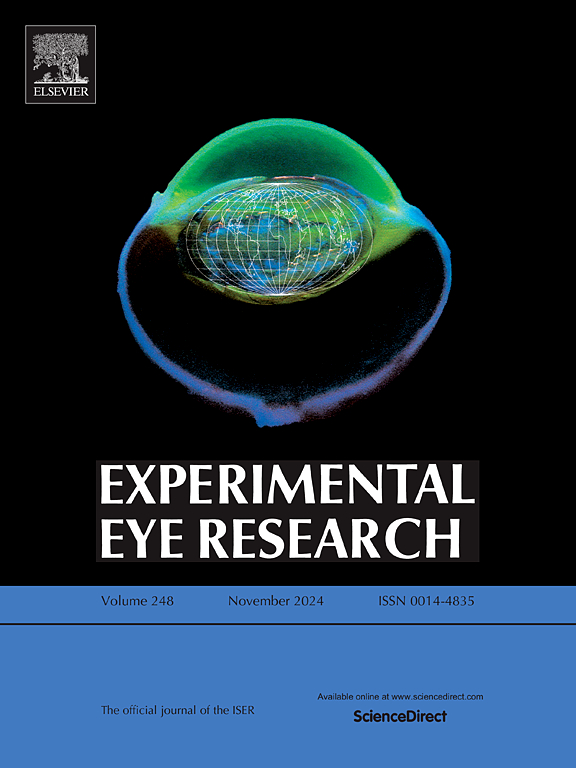Enabling visualization of GFAP-positive retinal glial cells, neurons and microvasculature in three-dimensions
IF 3
2区 医学
Q1 OPHTHALMOLOGY
引用次数: 0
Abstract
Glial cells are one of the most numerous cell types in the vertebrate retina and they serve to support neurovascular function. The principal glial cell in the retina is the Müller cell, accounting for approximately 90 % of all retinal glial cells. Müller cells are phenotypically elongated in shape and were first described as ‘radial fibers’ by Heinrich Müller in 1851. Their structure spans the entire thickness of the retina, through all retinal layers from the internal to external limiting membrane. This unique three-dimensional spatial arrangement enables Müller cells' direct contact with almost all cell types in the retina to perform its function. Despite this, the current study of Müller cells has largely been limited to thin sections or in culture, which provide limited detail about its spatial arrangement and interconnection with other cell types. The novel technique described here enables the three-dimensional visualization of GFAP-positive Müller cell processes in rodent retina and is based on the isolated arterially perfused rat eye preparation. Our micro perfusion technique utilizes the microvasculature as the delivery channel to quickly and effectively preserve all retinal elements. Intravascular labelling enables visualization of the intact three-dimensional retinal microvasculature within its normal neuronal and glial confines. Additional immersion immunolabeling and subsequent clearing with RapiClear® enables the three-dimensional visualization of different retinal elements and their physical interaction. Volume rendering of confocal image stacks acquired from these specimens can facilitate the study of such interactions in normal and disease models to further our understanding. This technique may be replicated in human donor retinae for future investigations to provide insight into Müller cell form and spatial relationship with other cell types.
使gmap阳性的视网膜胶质细胞、神经元和微血管三维可视化成为可能。
神经胶质细胞是脊椎动物视网膜中数量最多的细胞类型之一,它们支持神经血管功能。视网膜中主要的神经胶质细胞是束状细胞,约占所有视网膜神经胶质细胞的90%。m ller细胞呈细长状,1851年由Heinrich m ller首次描述为“径向纤维”。它们的结构横跨视网膜的整个厚度,穿过从内部到外部的视网膜限制膜的所有视网膜层。这种独特的三维空间安排使m ller细胞能够与视网膜上几乎所有类型的细胞直接接触,从而发挥其功能。尽管如此,目前对m ller细胞的研究在很大程度上仅限于薄片或培养,这提供了有限的关于其空间排列和与其他细胞类型互连的细节。本文所描述的新技术能够实现啮齿动物视网膜中gmap阳性的 ller细胞过程的三维可视化,并基于分离的动脉灌注大鼠眼睛制备。我们的微灌注技术利用微血管作为输送通道,快速有效地保存视网膜的所有元素。血管内标记使完整的三维视网膜微血管在其正常的神经元和神经胶质范围内可视化。额外的浸入式免疫标记和随后的RapiClear®清除可以实现不同视网膜元素及其物理相互作用的三维可视化。从这些标本中获得的共聚焦图像堆栈的体绘制可以促进正常和疾病模型中这种相互作用的研究,以进一步我们的理解。这项技术可以在人类供体视网膜中复制,用于未来的研究,以深入了解 ller细胞的形态和与其他细胞类型的空间关系。
本文章由计算机程序翻译,如有差异,请以英文原文为准。
求助全文
约1分钟内获得全文
求助全文
来源期刊

Experimental eye research
医学-眼科学
CiteScore
6.80
自引率
5.90%
发文量
323
审稿时长
66 days
期刊介绍:
The primary goal of Experimental Eye Research is to publish original research papers on all aspects of experimental biology of the eye and ocular tissues that seek to define the mechanisms of normal function and/or disease. Studies of ocular tissues that encompass the disciplines of cell biology, developmental biology, genetics, molecular biology, physiology, biochemistry, biophysics, immunology or microbiology are most welcomed. Manuscripts that are purely clinical or in a surgical area of ophthalmology are not appropriate for submission to Experimental Eye Research and if received will be returned without review.
 求助内容:
求助内容: 应助结果提醒方式:
应助结果提醒方式:


